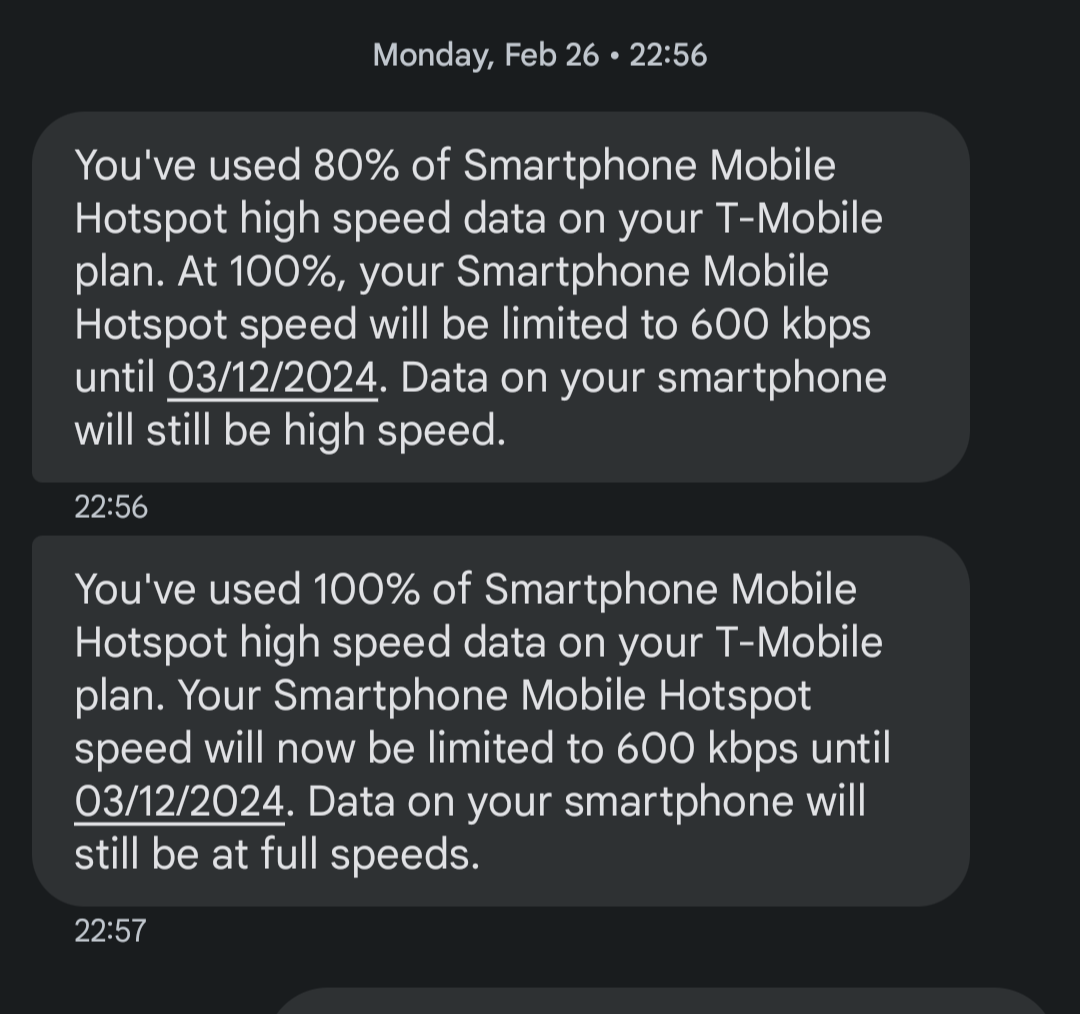What is the difference between cellular data being used on my phone and cellular data being used on my notebook? Data is data.
This is why we need net neutrality
And more competition.
T-Mobile hasn’t done this for years. Att is just shit
Uh?

When T-Mobile moved to unlimited with the ONE plans, they gave You “unlimited” tethering at “3G speeds”, which turned out to be 0.5Mbit/s, an unusably slow speed in 2018.
The Magenta plans gave you 5GB-50GB of full-speed tethering before dropping you to “3G speeds”. The current Go5G plans are similar, with a limited amount of usable tethering data before you’re, for all practical uses, cut off.
Before the ONE plans, there technically was no hotspot usage limit, but since you had a limited amount of high-speed data, your hotspot was effectively limited to whatever your plan gave you.
All the US carriers limit hotspot usage, partly to prevent someone hooking up a computer to download 50TB of pirated movies while clogging up the bandwidth for everyone else on that tower, and (moreso) partly because they’re greedy.
3g speeds are fine, no clue what you’re talking about. I literally tether all the time and when I hit the limit it’s still completely usable, even for YouTube. And getting to that limit is well above the 5gb from ATT. Like I said, att is shit, T-Mobile doesn’t do this and hasn’t for years.
Literally every carrier on the planet limits hotspot data in some manner. This isn’t a US thing.
100% this
yeah they are selling “wireless home internet” hard now, can’t have people using their phone hotspot for that.
This is one of those ‘innovations’ people mean when they say capitalism drives innovation. Not the hotspot, the pointless extra charge for something your phone can just do on its own.
How do they even know if you use your data as a hotspot? That’s just ridiculous!
Probably local/system services on the app when the SIM is activated (like it’s with sim locked phones)
Nope, it’s either inspecting the TTL of packets coming from your phone (unless you have a VERY custom setup, the TTL from devices other than your phone will be very different), or it’s deep packet inspection. I tried to trick t-mobile last year into giving me home internet on a phone sim, so I did a whack ton of research.
Did you find a way to avoid detection?
On US Mobile (Verizon) using a VPN on my phone when tethering seems to bypass detection. At least the meter on the dashboard says I’ve used 0gb hotspot.
My ISP’s a dick, but to my knowledge, unlimited has to mean unlimited around here. There where months where we had Problems with our fibre, so I did everything over a hotspot from my phone. Used 100’s of GB’s no one ever complained.
Get proper consumer protection laws, people.
*Cries in American.*
Get proper consumer protection laws, people.
And if you’re homeless, just buy a house 🫶
It really is the same energy
I’ve had great success getting around these restrictions.
CalyxOS + Always on VPN (mullvad)
The secret sauce is using a Android version that allows you to share your VPN with hotspotting. I believe only calyxos and lineage allow you to do this. Since the VPN client is running on the phone, all the traffic that originates from the phone will look like phone data, with the appropriate time to live, OS fingerprinting, etc.
This can’t be done on stock Android, because it does not allow the VPN to be shared over tethering. So tethering traffic will not getting capsulated on the VPN client. There’s a security argument for this, but I prefer the user flexibility of allowing all the traffic to get VPNed.
It’s still possible to do this without VPN sharing on the phone, you can use normal tethering on a unlocked phone, like stock Android. You just have to modify the traffic signature to look like whatever the carrier is looking for. Setting the appropriate time to live, using a VPN, and doing other OS fingerprinting tricks to keep the traffic consistent. It’s much easier to use a ROM that lets you share the VPN
How do they know if the source of data is hotspot? I’d imagine there is a way to stop your phone grassing on you.
There’s different internal network configs (APNs), and hotspot uses a different one than regular mobile data. ( or at least it used to). Those can be configured and metered separately from the carrier’s end.
LineageOS, and maybe some other custom ROMs, wouldn’t do that and would put the hotspot and mobile data on the same APN to get around that.
Can confirm, switching to Graphene solved this problem for me a long while ago.
Doesn’t unlocking the bootloader break Google Pay?
You can in theory still use Google Pay with a Magisk module called Play Integrity Fix and using a fingerprint from a different phone to pass Basic and Device integrity. I’m currently doing it on my Pixel 7 Pro.
But it has a steep learning curve and is a temporary solution that will disappear in roughly a year once Google sunsets legacy integrity methods and starts requiring Strong integrity, which can’t be faked under known methods. Google is also actively disabling fingerprints that are being spoofed, making the whole thing frustrating and even more temporary even when it works.
Just let us use our devices, sheesh.
Laptops have large screens and windows software isn’t designed to be data efficient. Unlimited data doesn’t mean at full speed infinitely. They sell way more than they can support otherwise it would be impossible to support more than a few users at one time on a cell tower.
“They sell more than they can support”
At that point is where mine and your opinion diverge. In what sustainable business does one sell more of anything than they can maintain responsibility over?
Of course, there are many examples, but why?
Greed is why. Don’t sell something you cannot sustain, or you have misled your customer.
I hope the user finds a way around this and burns all of the data they rightfully purchased. Plan says unlimited. Rename the plan if its a lie.
Finally, and not directed at the user to which I am replying, what concerns me the most is that this quote I took from your post would be glossed over by most because it is what we’ve come to expect from fucky corps. We don’t have to take it, change your expectations, question the system.
At that point is where mine and your opinion diverge. In what sustainable business does one sell more of anything than they can maintain responsibility over?
What they’re talking about is the mobile provider overselling service. Because they know that for the vast majority of the time, everyone isn’t going to be demanding huge amounts of bandwidth all at the same time. Cable/GPON fiber ISPs do the same thing.














